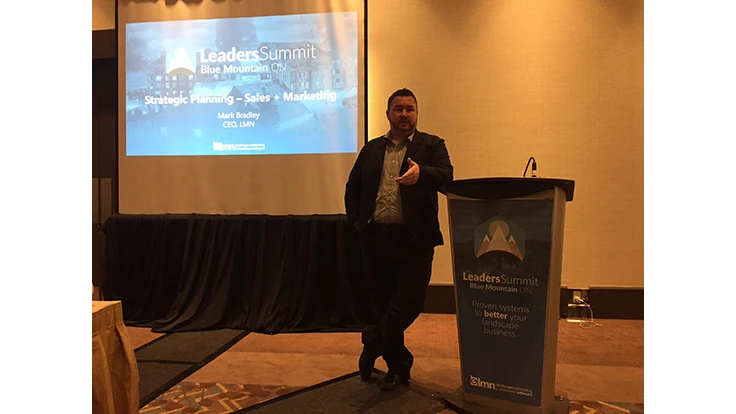
I spent a few days up in Canada last week at the Landscape Management Network Leader’s Summit, a three-day conference where landscape contractors discussed how to improve their sales process and set up a strategic plan, and got some motivational insight from a two-time gold medal winner.
The event, sponsored by Caterpillar, Unilock, Greenius, Clintar and Landscape Ontario, brought together 175 contractors from the U.S. and Canada to share best practices, and focused on building a strategic plan.
Mark Bradley is the chief executive officer of TBG Landscape, a design/build company in Ontario that last year posted revenue of $28.7 million. He’s also the CEO of Landscape Management Network, the business software company he started based on the technology he created at TBG. He outlined for the attendees how he sets up strategic plans for his landscape company and software firm.
Strategic planning involves not just owner, but key team members as well.
Bradley said that a successful strategic plan – a document that shows where you want your company to go in the future – starts with getting input from your employees. They have an idea of where they see the company going and they’re also going to be the people who implement the tactics to achieve the strategy, so they need to be included in the process.
“I can only set the direction based on input from my team, and I can only hope for it to happen if they’re really engaged by the direction that I set,” Bradley said, adding that he includes managers and foremen in the discussion. “It gives us a chance to really think about where we want to take the company in the coming years and how we’ll get there.”
This inclusion should improve morale and strengthen your team, he said. Everyone will understand why you do things in the business, and where you see the business going in the future.
“If they get confused in your business, they have a hard time seeing where they’re going in their career,” Bradley said, making strategic planning a retention tool as well as a planning tool.
Strategic planning should ultimately improve your company in little ways as well as big ways.
By setting out clear goals and objectives for the company, you also identify the obstacles holding you, your team or the operation as a whole back, Bradley said.
“If you think your business is the only dysfunctional business in the room, you’re wrong,” he said.
Strategic planning starts with fact finding.
In the early days, TBG had a Friday cookout with crews to find out what customers were saying and what field employees needed to perform better. Those grew into town hall meetings to hear about problems, areas for improvement and how employees from different divisions saw the business.
“Getting this input from anybody that does sales, accounting, billing … maybe it’s 3-4 foreman … involve everyone, down to entry-level positions,” Bradley said. “They’ll have different input than what you might. That’s what strategic planning is all about – identifying all the problems.”
Use those facts to set goals and solve problems.
Bradley likes to create systems to fix simple problems his fact-finding uncovers. For example, he found out his crews were spending too much time fueling up their trucks, so he hired a third-party fueling company to gas up the equipment after hours. “These improvements come quite naturally once we identify the problem and once we pull out of the day-to-day chaos and look at it through a clear lens.”
Share your plan.
Take the time to share your vision from top to bottom. The owner should be able to walk up to any person and ask them about the direction of the company and they should have the same answer, Bradley said.
Ultimately, strategic planning sets goals and a clear path for the company’s success, but also employees’ success, Bradley said, and that’s what owners should keep in mind.
“At the end of the day, we all work for a better quality of life,” he said. “How can everybody on your team enjoy a better life as the result of the company?”
Here are some other tips, trick and suggestions from conference:
A website is great, but a bad one isn’t better than not having one. Bradley said that every landscaper should have a website because it’s the first place potential customers are going to look for information. “You can count on the fact that your client is going to google you when they get home,” he told attendees.
But a bad site is going to hurt you more than it helps you, Bradley said. "You should not have a website before you have a bad one. If it's not selling exactly what you want to sell ... then it’s hurting you.”
Go for the gold. Heather Moyse, two-time Canadian Olympic gold medalist in bobsledding, gave attendees some motivation to develop goals, not just dreams. She told them they needed to build a plan to achieve what they wanted, not just wait around for it to happen.
“Excuses really are absolutely everywhere. You have to find courage to step outside your comfort zone and feel exposed to see what you’re really capable of,” she said. Everyone runs into obstacles, but it’s our reaction to them that defines who we are. “Will you be the one who gets stopped by it? Or will you be the one who gets motivated by it?” she asked.
Bradley’s sales process.
Bradley made his bones selling residential design/build work in the greater Toronto area. Now his $28 million company does mostly environmental remediation and park construction, but he shared some of his sales tips from when he started with the audience:
1. Reception should be trained to screen and process initial sales call with initial information
2. Meet at the prospect’s house after dinner so they’re not rushed.
3. Bring a file with their name on it, a leave-behind portfolio with design and permit drawings, and photos (this sells you as an expert creatively and technically). “Some people want to buy art, some people want to buy function, some people want to buy both,” Bradley said. “We have to be prepared.”
4. Park in the street and walk up the driveway. Start gathering information right away – notice if the property is neat, well-maintained, what kind of cars they have. Inside, look at their furniture, artwork, the design of their kitchen. “I can’t sell them anything if I don’t know their taste,” he said.
5. Take your time. Plan on spending at least 1-3 hours so you can ask a lot of questions and really listen to what the homeowner is looking for. “I was always very slow with my meetings, never in a hurry,” he said.
Editorial comment: Canadians are just as polite as you think. I have traveled to Canada many times, and have found this to always be the case. Here are three anecdotal examples that prove our neighbors to the north are just nice.
- Bradley said he unionized TBG a few years ago to help ensure that even the lowest-paid members of the crews had the potential to make $100,000 a year. “That's when I felt most successful,” he said.
- Another contractor from the Toronto area told me that he doesn’t do snow and ice management services because it grinds up his employees. “I don’t want my guys doing something they’re not passionate about,” he told me.
- And, when Moyse was speaking about winning her two gold medals, she passed them around the audience so we could take pictures with them.
I stand by my statement that Canadians are just the best.
Latest from Lawn & Landscape
- To Lease or Not to Lease
- TruGreen taps Brian Bugara as chief revenue officer
- The Toro Company names Conserva Irrigation as 2024 Water Smart Partner of the Year
- Bland Landscaping acquires Koehn Outdoor
- The first issue of 2025 is live
- Wrapping up a wild week in M&A
- KeyServ Company adds Trim All Lawn Service in Florida
- Educating the green industry’s next generation





